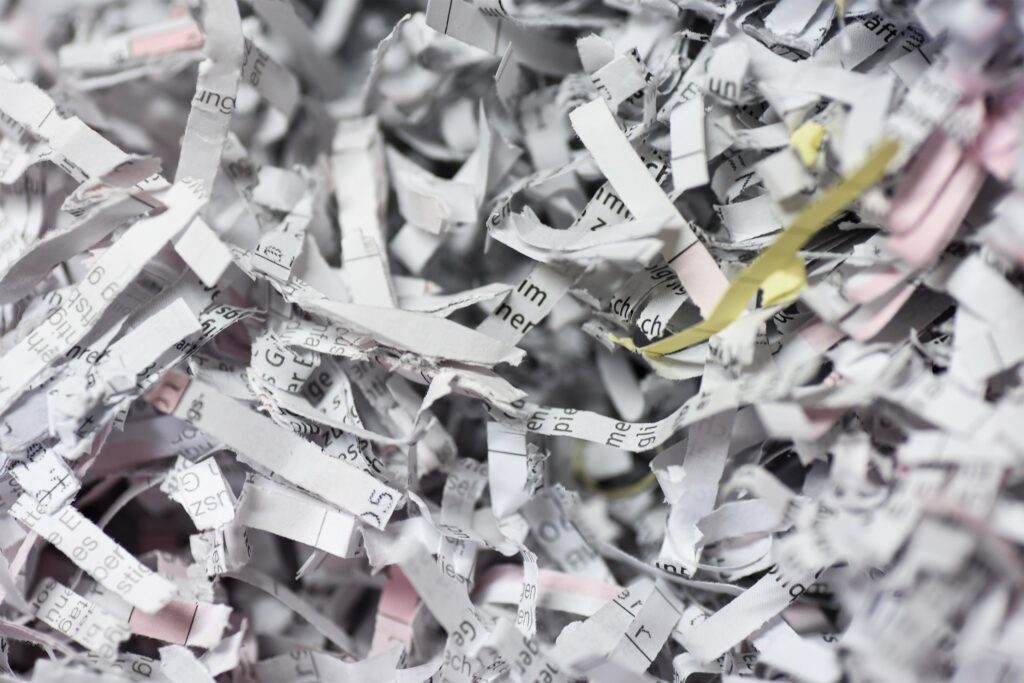
Running a business means generating paperwork—lots of it. From tax forms and invoices to employee files and contracts, it doesn’t take long for filing cabinets and storage rooms to fill up. But not every document needs to be kept forever. In fact, holding onto sensitive records longer than necessary can increase your legal risks and take up valuable space.
So how do you know what to keep and what to shred? This simple retention guide breaks down document lifecycles and offers clear guidance on when (and why) to securely dispose of outdated files.
Why Secure Shredding Matters for Businesses
Improperly discarded business documents can lead to serious consequences:
- Data breaches from exposed client or employee information
- Regulatory violations for failing to comply with privacy laws like HIPAA or FACTA
- Legal liabilities from outdated contracts or sensitive correspondence
- Cluttered offices and inefficient storage practices
Shredding old documents protects your business, your customers, and your bottom line. It also supports a more organized and compliant document management strategy.
General Retention Guidelines for Common Business Documents
While retention laws vary by industry and state, here’s a general breakdown of how long to keep various types of business records before shredding:
| Document Type | Recommended Retention |
|---|---|
| Tax Records & Filings | 7 years |
| Employee Payroll Records | 3–7 years |
| Employee Personnel Files | 7 years after termination |
| Bank Statements | 3 years |
| Client Contracts & Agreements | 6 years after completion |
| Accounts Payable/Receivable | 7 years |
| Insurance Policies | 6 years after expiration |
| Legal Documents | Permanently (or per counsel) |
| Emails with Financial Info | 3–7 years (archived digitally) |
Keep in mind that specific regulations such as HIPAA, SOX, IRS codes, or other state and local laws may require longer retention for certain industries.
The Hidden Risks of Keeping Documents Too Long
Many businesses err on the side of caution and end up storing records far longer than necessary. But excessive archiving can backfire. Risks include:
- Storage cost creep from expanding file rooms or long-term offsite storage
- Inefficient retrieval and cluttered digital systems
- Increased chance of a data leak due to forgotten or poorly protected records
A retention policy that includes scheduled shredding ensures your business only keeps what it needs—and nothing more.
When to Shred: Trigger Events for Document Disposal
Knowing when to shred can be just as important as knowing what to shred. Here are common milestones that signal it’s time to securely dispose of files:
- End of a fiscal year (good time for audits and cleanouts)
- Employee departure (shred non-essential files after retention period)
- Contract expiration
- Office relocation or downsizing
- After digitization (paper copies can often be destroyed once scanned and verified)
- Retention period ends (based on your company’s retention schedule)
Learn more about digitization with our Ultimate Scanning Guide →
What to Look for in a Business Shredding Provider
Not all shredding services are created equal. For secure, compliant disposal, partner with a shredding company that offers:
✅ On-demand or scheduled pickups
✅ Cross-cut or micro-cut shredding for maximum security
✅ Locked collection bins for your office
✅ Chain-of-custody documentation
✅ Certificate of destruction for audit compliance
✅ HIPAA, FACTA, and GLBA compliance, depending on your industry
A trusted shredding provider becomes an extension of your data security strategy, not just a vendor.
Should You Consider Offsite Document Destruction?
While onsite shredding is useful for highly sensitive materials, offsite shredding offers advantages for bulk records cleanouts:
- Lower cost per pound
- Efficient for file room purges or office cleanups
- Handled at secure, monitored shredding facilities
- Ideal for recurring shredding schedules
If your business generates large volumes of paper but lacks space or staff for in-house destruction, offsite shredding is a smart, compliant solution.
Build a Simple Document Retention and Shredding Policy
Every organization should have a written retention and destruction policy that answers:
- What documents are created and stored?
- Where are they stored (physical or digital)?
- How long is each document type retained?
- Who is responsible for monitoring and shredding?
- How is shredding conducted and documented?
Train your staff to follow the policy consistently and schedule regular shredding days to stay ahead of document bloat.
Shredding isn’t just a housekeeping task—it’s a vital step in protecting your business and staying compliant with state and federal regulations. By understanding how long to retain documents and when to securely dispose of them, you can reduce risk, reclaim office space, and operate more efficiently.
Need help purging your archives or building a shredding schedule?
Contact us today to request a document shredding quote →



